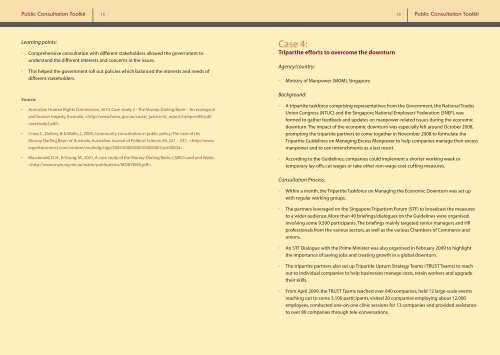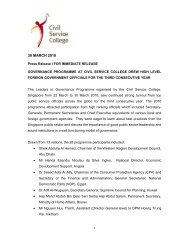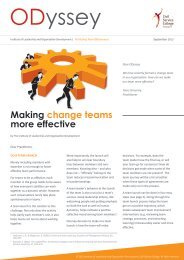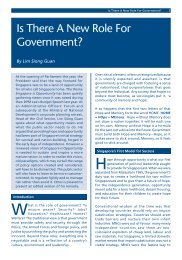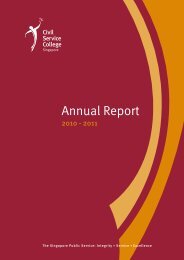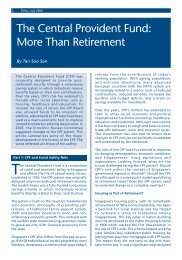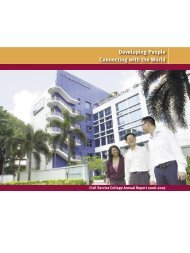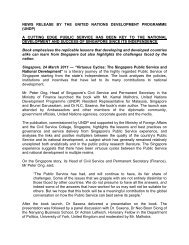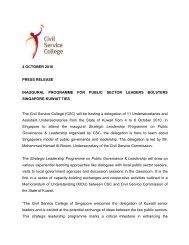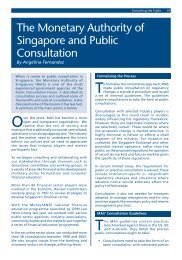Public Consultation Toolkit - Civil Service College
Public Consultation Toolkit - Civil Service College
Public Consultation Toolkit - Civil Service College
You also want an ePaper? Increase the reach of your titles
YUMPU automatically turns print PDFs into web optimized ePapers that Google loves.
<strong>Public</strong> <strong>Consultation</strong> <strong>Toolkit</strong> 15 16 <strong>Public</strong> <strong>Consultation</strong> <strong>Toolkit</strong><br />
Learning points:<br />
• Comprehensive consultation with different stakeholders allowed the government to<br />
understand the different interests and concerns in the issues.<br />
• This helped the government roll out policies which balanced the interests and needs of<br />
different stakeholders.<br />
Case 4:<br />
Tripartite efforts to overcome the downturn<br />
Agency/country:<br />
• Ministry of Manpower (MOM), Singapore<br />
Source:<br />
• Australian Human Rights Commission, 2010, Case study 2 - The Murray-Darling Basin – An ecological<br />
and human tragedy, Australia, .<br />
• Crase, L., Dollery, B. & Wallis, J., 2005, Community consultation in public policy: The case of the<br />
Murray-Darling Basin of Australia, Australian Journal of Political Science, 40, 221 – 237, .<br />
• Macdonald, D. H., & Young, M., 2001, A case study of the Murray-Darling Basin, CSIRO Land and Water,<br />
.<br />
Background:<br />
• A tripartite taskforce comprising representatives from the Government, the National Trades<br />
Union Congress (NTUC) and the Singapore National Employers’ Federation (SNEF), was<br />
formed to gather feedback and updates on manpower-related issues during the economic<br />
downturn. The impact of the economic downturn was especially felt around October 2008,<br />
prompting the tripartite partners to come together in November 2008 to formulate the<br />
Tripartite Guidelines on Managing Excess Manpower to help companies manage their excess<br />
manpower and to use retrenchments as a last resort.<br />
• According to the Guidelines, companies could implement a shorter working week or<br />
temporary lay-offs, cut wages or take other non-wage cost-cutting measures.<br />
<strong>Consultation</strong> Process:<br />
• Within a month, the Tripartite Taskforce on Managing the Economic Downturn was set up<br />
with regular working groups.<br />
• The partners leveraged on the Singapore Tripartism Forum (STF) to broadcast the measures<br />
to a wider audience. More than 40 briefings/dialogues on the Guidelines were organised,<br />
involving some 9,500 participants. The briefings mainly targeted senior managers and HR<br />
professionals from the various sectors, as well as the various Chambers of Commerce and<br />
unions.<br />
• An STF Dialogue with the Prime Minister was also organised in February 2009 to highlight<br />
the importance of saving jobs and creating growth in a global downturn.<br />
• The tripartite partners also set up Tripartite Upturn Strategy Teams (TRUST Teams) to reach<br />
out to individual companies to help businesses manage costs, retain workers and upgrade<br />
their skills.<br />
• From April 2009, the TRUST Teams reached over 640 companies, held 12 large-scale events<br />
reaching out to some 3,100 participants, visited 20 companies employing about 12,000<br />
employees, conducted one-on-one clinic sessions for 13 companies and provided assistance<br />
to over 80 companies through tele-conversations.


